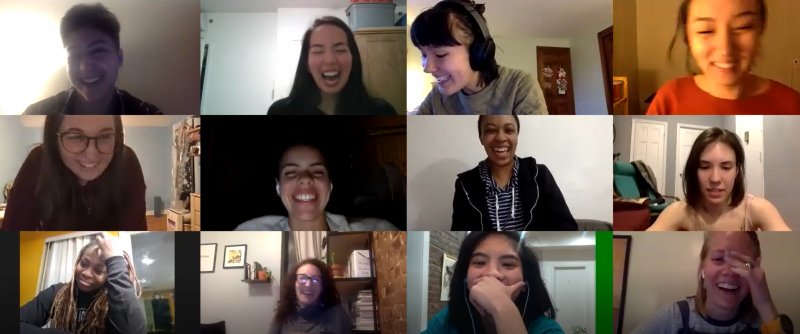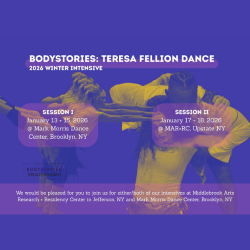Junior Committee
Friday, March 20, 2020
Learned and Gathered Best Practices for (Actually Joyful) Virtual Meetings
 Screenshot, via Danielle Iwata
Screenshot, via Danielle Iwata
With the call for social distancing in response to the spread of COVID-19, many organizations and artists have made the shift to virtual meetings and digital ways of gathering. In response to some of the feelings of frustration about this—for many, but not all—new way of meeting, we thought it would be useful to share some of the best practices we have developed for making virtual meetings not just efficient and effective, but also joyful, playful, and grounded in community.
THE WHY
Dance/NYC’s Junior Committee made the decision at the start of our 2019-20 year to make half of our meetings in-person and half of our meetings “virtual” (via video conference, using Zoom). The reason for this shift was to increase the accessibility of our meetings. New York City’s public transit system is notoriously difficult to navigate for individuals with disabilities and cutting back on the need for that travel by 50% would make our meetings a more inclusive space. Accessibility has been a major priority for Dance/NYC and we were proud to align our practices with our values by making this shift.
THE PRACTICAL
These are a few basic practices that have helped make our virtual meetings successful:
- Decide who is facilitating each portion of the meeting. Even if everyone is participating, it is often helpful to have someone responsible for inviting individuals into the conversation and managing the agenda.
- If there are more than four speakers on a call, mute yourself to minimize background noise when you’re not speaking. (And if you are the host of the meeting, you can mute all participants if it gets out of hand!).
- If you’re in a public or shared space, wear headphones to protect the confidentiality of the other speakers on the call.
- Make use of the chat function to voice agreement, pose questions, or have side conversations, as needed. Rather than interrupting the flow of the larger group conversation, you can direct message individuals with smaller questions or comments that emerge.
- For large groups, set a speaking order for any portions of the meeting that involve participation from everyone. On JComm, we always share personal updates at the top of each meeting. To make that move smoothly, the facilitator pastes a speaking order in the chat box (we use the order in which people arrived at the call, since everyone’s view of the screen will be different). When it comes time to share those updates, individuals unmute themselves and share according to that order, which minimizes confusion and cross-talk.
- Make use of non-verbal cues. To gauge agreement or readiness to move on, we often say, “give a thumbs up if you’re ready to move on.” This allows us to get participation from folks without requiring everyone to speak at once.
THE PLAYFUL
One of the most wonderful aspects of participation in JComm is the community. We wanted to make sure that the community wouldn’t feel any less real or vibrant when meeting virtually. We also wanted to avoid the cold, detached feeling of a corporate conference call or a webinar or lecture that you passively listen to but aren’t engaged with in a real way. To do that, we’ve tried to incorporate opportunities for playfulness, silliness, joy, and movement in our virtual meetings. After all, dance is what brings us together!
Though this time could look different for every group, one recent fun example is our digital dancemaking. We set an order, put on a song, and built a digital dance together. It was quick and easy to do, broke up the flow of the meeting, got people out of their brains and into their bodies, and invited room for some much needed silliness.
We have also integrated creative elements into deeper conversations. One of our subcommittees guided us through a debrief of the Bystander Intervention Training we participated in, and asked us to develop a gesture that symbolized each of the five intervention techniques. Throughout the conversation, our discussion leaders would ask questions and we would respond with movement. Similar to digital dancemaking, there was certainly an element of silliness involved, but it allowed us to feel more engaged through our communal movements and more invested in the conversation.
THE LEARNING
It’s critically important to approach virtual meetings with a new mindset: you should not try to replicate in-person meetings on the platform. When you expect for everything to function the same way, you’ll end up disappointed. In this time of so much uncertainty, it may be valuable to hold tight to your routines, but it’s just as valuable to acknowledge all that is different and changing. In the same way, we acknowledge that a virtual meeting will never be the same as an in person one, but instead of being disappointed by that, we see it as a source of potential and possibility.
Throughout our past eight months of meetings in this format, we have made many changes. Those changes have come from continued personal research and trainings around accessibility, as well as feedback gathered from our members. We do not see this list of best practices as a final one or a perfect one and anticipate that we will only continue to iterate on it as we learn together, but we encourage you to begin that learning. Here are a few resources that may help get you started:
- Dance/NYC’s work on the Disability.Dance.Artistry initiative and resource list
- Dance/NYC’s guide for creating accessible events
- Respectability, an organization that offers frequent webinars and sessions on increasing inclusion and accessibility
- Christine Bruno’s Disability Inclusion Consultancy
- Simi Linton’s Disability/Arts Consultancy and book Claiming Disability
- Diversability, an online and offline community created to connect, showcase, and empower people of all abilities doing amazing things.
- “Disabled people have worked remotely for years, and they’ve got advice for you and your bosses,” via the Washington Post



